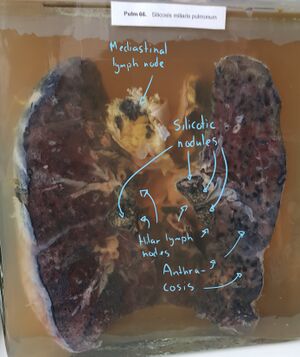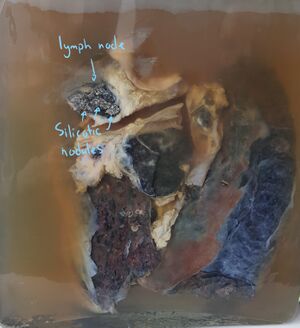58. Silicosis: Difference between revisions
No edit summary |
No edit summary |
||
| Line 1: | Line 1: | ||
'''Organ''': Lung + lymph nodes | [[File:Silicosis prep front.jpg|thumb|Silicosis prep front]]'''Organ''': Lung + lymph nodes | ||
'''Description''': | '''Description''': | ||
| Line 13: | Line 13: | ||
* Occupational disease, silica dust inhalation | * Occupational disease, silica dust inhalation | ||
'''Theory''': | '''Theory''': | ||
Several occupations are associated with exposure to silica dust, like miners and stone cutters. When these people inhale the dust, it will be eaten by alveolar macrophages. However, because the silica dust is inorganic can’t the macrophages break it down. The macrophages respond by producing cytokines that recruit fibroblasts. Progressive fibrosis occurs. | |||
In this preparation are silicotic nodules not ''macroscopically'' visible in the lung parenchyme, however histology of the lung would definitely show those nodules. However, we can see silicotic nodules as greyish dots inside the hilar and mediastinal lymph nodes. | In this preparation are silicotic nodules not ''macroscopically'' visible in the lung parenchyme, however histology of the lung would definitely show those nodules. However, we can see silicotic nodules as greyish dots inside the hilar and mediastinal lymph nodes. | ||
Revision as of 10:40, 5 July 2024

Organ: Lung + lymph nodes
Description:
The lung parenchyme shows many black foci of anthracosis.
In the hilar and mediastinal lymph nodes we can see anthracosis here too, but small greyish dots as well.
Diagnosis: Silicosis
Causes:
- Occupational disease, silica dust inhalation
Theory:
Several occupations are associated with exposure to silica dust, like miners and stone cutters. When these people inhale the dust, it will be eaten by alveolar macrophages. However, because the silica dust is inorganic can’t the macrophages break it down. The macrophages respond by producing cytokines that recruit fibroblasts. Progressive fibrosis occurs.
In this preparation are silicotic nodules not macroscopically visible in the lung parenchyme, however histology of the lung would definitely show those nodules. However, we can see silicotic nodules as greyish dots inside the hilar and mediastinal lymph nodes.
Anthracosis in this preparation is also severe, because workers that are exposed to silica crystals are also exposed to high amounts of coal and carbon dust.

